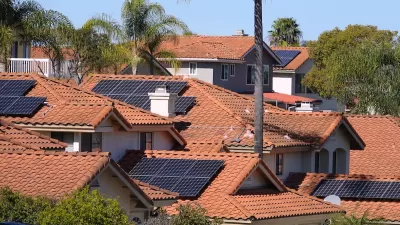A German led initiative called 'Desertec,' aims to provide 15% of Europe's electricity by 2050 through a vast network of solar and wind farms stretching right across the MENA region and connecting to Europe via direct current transmission cables.
Gerhard Knies, a German particle physicist, was the first person to estimate how much solar energy was required to meet humanity's demand for electricity. In 1986, in response to the Chernobly accident, he concluded that in just six hours, the world's deserts receive more energy from the sun than humans consume a year.
Until recently the plan to give over portions of Saharan Desert to solar energy production seemed fanciful, but in the last two years an international consortium of companies has formed Desertec Industrial Initiative (Dii). Last month, Dii announced that the first phase of the Desertec Plan will begin construction in Morocco next year near Ouarzazate.
Opponents of the project have argue that Dii is too dominated by German interests and that the project carries with it a sense of neo-colonialist exploitation. "Many Africans are sceptical [about Desertec]," says Daniel Ayuk Mbi Egbe of the African Network for Solar Energy. "[Europeans] make promises, but at the end of the day, they bring their engineers, they bring their equipment, and they go. It's a new form of resource exploitation, just like in the past."
FULL STORY: Could The Desert Sun Power The World?

Alabama: Trump Terminates Settlements for Black Communities Harmed By Raw Sewage
Trump deemed the landmark civil rights agreement “illegal DEI and environmental justice policy.”

Study: Maui’s Plan to Convert Vacation Rentals to Long-Term Housing Could Cause Nearly $1 Billion Economic Loss
The plan would reduce visitor accommodation by 25% resulting in 1,900 jobs lost.

Planetizen Federal Action Tracker
A weekly monitor of how Trump’s orders and actions are impacting planners and planning in America.

Wind Energy on the Rise Despite Federal Policy Reversal
The Trump administration is revoking federal support for renewable energy, but demand for new projects continues unabated.

Passengers Flock to Caltrain After Electrification
The new electric trains are running faster and more reliably, leading to strong ridership growth on the Bay Area rail system.

Texas Churches Rally Behind ‘Yes in God’s Back Yard’ Legislation
Religious leaders want the state to reduce zoning regulations to streamline leasing church-owned land to housing developers.
Urban Design for Planners 1: Software Tools
This six-course series explores essential urban design concepts using open source software and equips planners with the tools they need to participate fully in the urban design process.
Planning for Universal Design
Learn the tools for implementing Universal Design in planning regulations.
Caltrans
Smith Gee Studio
Institute for Housing and Urban Development Studies (IHS)
City of Grandview
Harvard GSD Executive Education
Toledo-Lucas County Plan Commissions
Salt Lake City
NYU Wagner Graduate School of Public Service




























